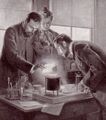Template:Selected anniversaries/December 26: Difference between revisions
Jump to navigation
Jump to search
No edit summary |
No edit summary |
||
| Line 1: | Line 1: | ||
<gallery> | <gallery> | ||
||Wilhelm Xylander | ||1532L Wilhelm Xylander born ... classical scholar and humanist. | ||
||1780 | ||1780: Mary Somerville born ... mathematician, astronomer, and author (d. 1872) | ||
File:Charles Babbage by Antoine Claudet c1847-51.jpg|link=Charles Babbage (nonfiction)|1791: Polymath [[Charles Babbage (nonfiction)|Charles Babbage]] born. He will construct mechanical computers which anticipate the concept of programmable digital computers. | File:Charles Babbage by Antoine Claudet c1847-51.jpg|link=Charles Babbage (nonfiction)|1791: Polymath [[Charles Babbage (nonfiction)|Charles Babbage]] born. He will construct mechanical computers which anticipate the concept of programmable digital computers. | ||
| | ||1837: Martin(us) van Marum born ... physician, inventor, scientist and teacher, who studied medicine and philosophy in Groningen. Van Marum introduced modern chemistry in the Netherlands after the theories of Lavoisier, and several scientific applications for general use. He became famous for his demonstrations with instruments, most notable the Large electricity machine, to show statical electricity and chemical experiments while curator for the Teylers Museum. | ||
|| | ||1861: Emil Johann Wiechert born ... physicist and geophysicist who made many contributions to both fields, including presenting the first verifiable model of a layered structure of the Earth and being among the first to discover the electron. | ||
|| | ||1862: The largest mass-hanging in U.S. history took place in Mankato, Minnesota, 38 Native Americans died. | ||
||1896: Physicist Georgi Nadjakov born. He investigated the photoconducting properties of sulphur. He prepared the permanent photoelectret state of matter for the first time. Pic. | |||
||1896: Georgi Nadjakov born | |||
File:Emil du Bois-Reymond.jpg|link=Emil du Bois-Reymond (nonfiction)|1896: Physician and physiologist [[Emil du Bois-Reymond (nonfiction)|Emil du Bois-Reymond]] dies. He discovered nerve action potential, and developed experimental electrophysiology. | File:Emil du Bois-Reymond.jpg|link=Emil du Bois-Reymond (nonfiction)|1896: Physician and physiologist [[Emil du Bois-Reymond (nonfiction)|Emil du Bois-Reymond]] dies. He discovered nerve action potential, and developed experimental electrophysiology. | ||
| Line 22: | Line 20: | ||
File:Gustave Eiffel 1888.jpg|link=Gustave Eiffel (nonfiction)|1899: Engineer and crime-fighter [[Gustave Eiffel (nonfiction)|Gustave Eiffel]] uses [[Gnomon algorithm]] techniques to detect and prevent [[crimes against physics]]. | File:Gustave Eiffel 1888.jpg|link=Gustave Eiffel (nonfiction)|1899: Engineer and crime-fighter [[Gustave Eiffel (nonfiction)|Gustave Eiffel]] uses [[Gnomon algorithm]] techniques to detect and prevent [[crimes against physics]]. | ||
||Richard Hubert Bruck | ||1914: Richard Hubert Bruck born ... mathematician best known for his work in the field of algebra, especially in its relation to projective geometry and combinatorics. Pic. | ||
||1926: Ali Javan born ... physicist and inventor. He was the first to propose the concept of the gas laser in 1959 at the Bell Telephone Laboratories. Pic. | |||
|| | ||1973: Harold Hotelling dies ... mathematical statistician and an influential economic theorist, known for Hotelling's law, Hotelling's lemma, and Hotelling's rule in economics, as well as Hotelling's T-squared distribution in statistics. Pic. | ||
|| | ||1979: Helmut Hasse dies ... mathematician working in algebraic number theory, known for fundamental contributions to class field theory, the application of p-adic numbers to local class field theory and diophantine geometry (Hasse principle), and to local zeta functions. | ||
|| | ||1991: The Supreme Soviet of the Soviet Union meets and formally dissolves the Soviet Union. | ||
|| | ||1992: John George Kemeny dies ... mathematician, computer scientist, and educator He will co-develop the BASIC programming language, and pioneer the use of computers in college education. Pic. | ||
|| | ||1997: Cahit Arf dies ... mathematician and academic. | ||
||1997 | ||1997: Kenneth Sanborn Pitzer dies ... physical and theoretical chemist, educator, and university president.[1] He was described as "one of the most influential physical chemists of his era" whose work "spanned almost all of the important fields of physical chemistry: thermodynamics, statistical mechanics, molecular structure, quantum mechanics, spectroscopy, chemical bonding, relativistic chemical effects, properties of concentrated aqueous salt solutions, kinetics, and conformational analysis." | ||
||Vitold Belevitch | ||1999: Vitold Belevitch dies ... mathematician and electrical engineer of Russian origin who produced some important work in the field of electrical network theory. | ||
File:Martin David Kruskal.jpg|link=Martin David Kruskal (nonfiction)|2006: Physicist and mathematician [[Martin David Kruskal (nonfiction)|Martin David Kruskal]] dies. He made fundamental contributions in many areas of mathematics and science, including the discovery and theory of solitons. | File:Martin David Kruskal.jpg|link=Martin David Kruskal (nonfiction)|2006: Physicist and mathematician [[Martin David Kruskal (nonfiction)|Martin David Kruskal]] dies. He made fundamental contributions in many areas of mathematics and science, including the discovery and theory of solitons. | ||
||Wilfred Kaplan | ||2007: Wilfred Kaplan dies ... professor of mathematics. His research focused on dynamical systems, the topology of curve families, complex function theory, and differential equations. Pic. | ||
||Albert Ghiorso | ||2010: Albert Ghiorso dies ... nuclear scientist and co-discoverer of a record 12 chemical elements on the periodic table. | ||
File:Scrimshaw binge residue.jpg|link=Scrimshaw abuse|2016: Survey data reveals widespread [[Scrimshaw abuse|Scrimshaw binging]] the day after Christmas. | File:Scrimshaw binge residue.jpg|link=Scrimshaw abuse|2016: Survey data reveals widespread [[Scrimshaw abuse|Scrimshaw binging]] the day after Christmas. | ||
</gallery> | </gallery> | ||
Revision as of 06:57, 23 August 2018
1791: Polymath Charles Babbage born. He will construct mechanical computers which anticipate the concept of programmable digital computers.
1896: Physician and physiologist Emil du Bois-Reymond dies. He discovered nerve action potential, and developed experimental electrophysiology.
1898: Marie and Pierre Curie announce the isolation of radium.
1899: Engineer and crime-fighter Gustave Eiffel uses Gnomon algorithm techniques to detect and prevent crimes against physics.
2006: Physicist and mathematician Martin David Kruskal dies. He made fundamental contributions in many areas of mathematics and science, including the discovery and theory of solitons.
2016: Survey data reveals widespread Scrimshaw binging the day after Christmas.





